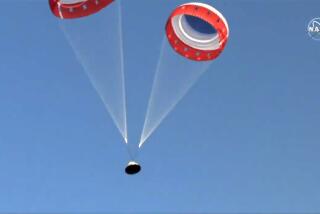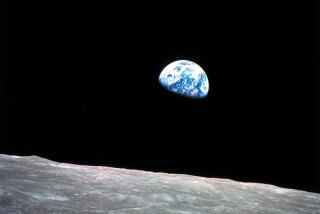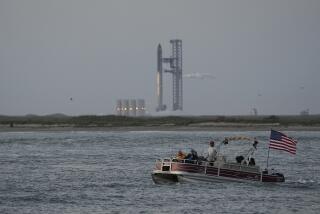Challenger disaster still haunts NASA 25 years later
Reporting from Washington — Two days before the space shuttle Challenger made its final flight, Carl McNair spoke to his brother Ron McNair on the telephone. It was mostly small talk: Super Bowl XX being played that day, William “Refrigerator” Perry, the weather.
“He said, ‘The weather is not looking good and things are icing up and I don’t think we are going to launch,’” recalled Carl McNair, who had come to Florida to watch his brother and six crew members launch into orbit.
So he headed home to Atlanta with his wife and father, expecting to return in a week to see his brother’s second spaceflight. Instead, on a cold Tuesday morning 25 years ago, he turned on the television and “there it was, taking off. I couldn’t believe it.”
Surprise turned to horror just over a minute later.
“As it got higher and higher, the solid rocket booster started to veer off, and I didn’t know how I knew. But I knew they were gone,” McNair said. “I stood there with tears streaming down my eyes, saying ‘Oh my God, oh my God’ — what so many people were saying in unison around the world.”
That moment on Jan. 28, 1986, replayed again and again by news networks, left a scar on the national psyche that haunts the country, and NASA, to this day.
The loss of seven astronauts — including New Hampshire teacher Christa McAuliffe — traumatized a nation that was fiercely proud of a program that had sent men to the moon. It also shattered the illusion that NASA was infallible — or at least close to it — as a subsequent investigation proved that the disaster could have been prevented.
A select commission led by former Secretary of State William Rogers concluded that the cause of the accident was a faulty O-ring in one of two solid-fuel rocket boosters. A breach in the O-ring allowed hot gases to escape and burn a hole in the shuttle’s 15-story external fuel tank, causing it to explode.
But there was more.
The frigid weather — it was 36 degrees at the time of the launch — caused the O-ring to shrink and give hot gases a pathway to escape. Worse, NASA managers had known about, and dismissed, partial failures of O-rings in previous launches and also ignored prelaunch warnings about the rings’ vulnerability in cold weather.
But it would take 17 years and the loss of another shuttle before NASA finally got the message. A report after the 2003 Columbia disaster noted that — Challenger notwithstanding — NASA had failed to change a culture that often rewarded ambition over safety.
Columbia was doomed when a briefcase-sized chunk of insulating foam peeled off the shuttle’s fuel tank during launch and punched a hole in the heat-resistant tiles on the leading edge of the orbiter’s left wing.
Columbia was cleared to return to Earth on the morning of Feb. 1. When searing gases generated by reentry entered the orbiter through the hole in the wing, Columbia disintegrated over Texas, killing the seven crew members.
Foam had been falling off the fuel tank for years, gouging chunks out of the orbiters’ heat-resistant tiles and, once before, allowing reentry heat to almost burn a hole in a shuttle’s belly. But NASA engineers, lacking a solution that would keep the foam in place, elected to ignore the issue.
“By the eve of the Columbia accident, institutional practices that were in effect at the time of the Challenger accident — such as inadequate concern over deviations from expected performance, a silent safety program, and schedule pressure — had returned to NASA,” investigators wrote.
Diane Vaughan, a Columbia University professor who researched the agency’s culture after both Challenger and Columbia, said the loss of Columbia was especially painful to employees who had lived through Challenger. “They had felt they had truly fixed things,” she said.
Vaughan said that post-Columbia NASA has a far different approach to safety.
“Look at the recent attempts to launch Discovery and how long they’ve stood down for that,” she said. “It doesn’t mean they [NASA engineers] are doing poorly. It means they identified a flaw and are taking safety seriously.”
Discovery’s next flight, now set for Feb. 24, has been delayed since early November by cracks in five support rods in the center of the external fuel tank. Engineers have worked carefully to figure out the cause, even pulling the shuttle back from the launchpad to the Vehicle Assembly Building for X-rays and other tests.
Outside NASA, the Challenger disaster has morphed into one of those shared traumas — like the Sept. 11, 2001, attacks or President Kennedy’s assassination — that serve as touchstones across generations.
Accentuating the grief was the loss of McAuliffe, a high school teacher selected to go into space to boost interest among children, many of whom were watching that day. One of them was novelist Diana Peterfreund, then a first-grader in Clearwater, Fla. Her teacher had brought the class outside to watch the launch — visible, if remotely, even to those on the other side of the state.
“The teachers were explaining the different parts of the rocket coming off … when someone came from inside and told them that something went wrong,” she said.
Peterfreund remembers the shock of seeing her teacher cry.
“It was almost like she was teaching us how we were supposed to feel; it made it more understandable,” she said.
President Reagan tried to act as a surrogate father to the nation’s students in an address on the night of Jan. 28, 1986.
“I want to say something to the schoolchildren of America who were watching the live coverage of the shuttle’s takeoff. I know it’s hard to understand, but sometimes painful things like this happen,” Reagan said. “It’s all part of the process of exploration and discovery. It’s all part of taking a chance and expanding man’s horizon.”
Orlando Sentinel Space Editor Robert Block contributed to this report.
More to Read
Sign up for Essential California
The most important California stories and recommendations in your inbox every morning.
You may occasionally receive promotional content from the Los Angeles Times.










